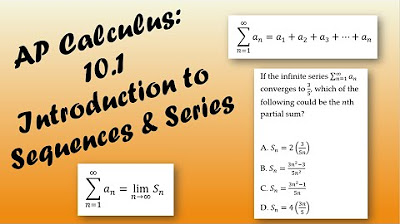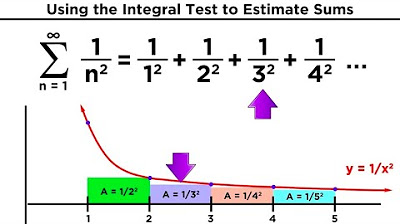What does it feel like to invent math?
TLDRThe video script explores the concept of infinite sums and their convergence, using the paradoxical example of the sum of powers of 2 equaling negative 1. It delves into the historical process of mathematical discovery, illustrating how early mathematicians might have approached defining infinite sums and the concept of 'approaching' a value. The script introduces the 2-adic metric, a distance function that provides a framework for understanding how certain infinite sums can converge to unexpected values, highlighting the cyclical nature of math discovery where fuzzy concepts lead to rigorous definitions and new mathematical tools.
Takeaways
- 🌟 The concept of infinite sums can be perplexing, yet they are a fundamental part of mathematical exploration.
- 📚 The idea that the sum of powers of 2 starting from 1 approaches negative 1 seems counterintuitive but is explored through rigorous mathematical reasoning.
- 🤔 Early mathematicians might have felt a sense of being wrong or stuck when faced with the concept of adding an infinite number of terms.
- 📈 The geometric interpretation of numbers approaching 1 is used to define the concept of convergence in infinite sums.
- 🔍 The process of discovering math often involves dissecting old thoughts and finding new definitions to make sense of paradoxical observations.
- 📊 The notion of 'approaching' a number is defined by the ability to get arbitrarily close to that number, no matter how small the desired distance.
- 🌐 The generalization of infinite sums leads to the discovery of more profound mathematical truths, such as the formula for sums involving powers of other numbers.
- 🔧 The mathematical community eventually found a way to define a distance function, known as the 2-adic metric, which provides a framework for understanding why the sum of powers of 2 equals negative 1.
- 💡 The story illustrates the cycle of mathematical discovery, where nature presents a challenge, and mathematicians construct rigorous definitions to address it, leading to new areas of study.
- 🌟 The debate of whether math is invention or discovery is addressed, with the narrative favoring the idea that discovery leads to the invention of useful mathematical concepts.
Q & A
What is the main idea the video script is trying to convey?
-The main idea is to illustrate the concept of convergent infinite sums and how seemingly nonsensical mathematical ideas can be explored and eventually understood through the process of discovery, leading to the development of new mathematical concepts and theories.
How does the script introduce the concept of infinite sums?
-The script introduces infinite sums by using the example of adding up fractions like 1/2, 1/4, 1/8, and so on, to infinity, and how this sum equals 1. It then extends this idea to more complex scenarios, such as the sum of powers of 2.
What is the significance of the early mathematician's thought process described in the script?
-The early mathematician's thought process is significant because it shows the struggle and the steps taken to define and understand infinite sums, highlighting the human aspect of mathematical discovery and the importance of perseverance in the face of initial confusion or incorrectness.
How does the script explain the concept of numbers approaching a certain value?
-The script explains that a number approaches a certain value if, no matter how small the distance you choose, eventually the numbers in the list will fall within that tiny distance of the chosen value. This is used to define what it means for an infinite sum to equal a certain number.
What is the role of the 2-adic metric in the script's explanation?
-The 2-adic metric is introduced as a new way of defining distance between numbers, which allows for the interpretation that powers of 2 approach zero. This metric is part of the p-adic metrics family and is crucial in understanding how the sum of all powers of 2 can equal negative 1 in a different mathematical framework.
How does the script address the idea that math is both invention and discovery?
-The script suggests that the discovery of non-rigorous or ill-defined ideas leads to the invention of rigorous terms and concepts, which are then useful for further discovery. This cycle continues, blurring the line between pure invention and abstract discovery in the realm of mathematics.
What is the strange equation mentioned in the script that initially seems false?
-The strange equation mentioned is that the sum of powers of 2 (1 plus 2 plus 4 plus 8 plus 16, and so on) equals negative 1. This equation initially seems false because adding increasing powers of 2 would intuitively lead to a very large number, not a negative one.
What does the script imply about the nature of mathematical progress?
-The script implies that mathematical progress often involves grappling with ideas that seem counterintuitive or nonsensical at first. Through exploration and the development of new concepts and definitions, these ideas can be understood and lead to broader mathematical insights.
How does the script use the concept of a number line to explain infinite sums?
-The script uses the concept of a number line by placing two objects at 0 and 1 and then repeatedly cutting the distance between them in half. The numbers that the first object touches during this process form an infinite sum, and the script explains that these numbers approach 1 as the process continues indefinitely.
What is the role of the notion of distance in the script's exploration of infinite sums?
-The notion of distance is crucial in the script's exploration as it provides a way to conceptualize how numbers approach certain values. By defining a new distance function (the 2-adic metric), the script is able to give meaning to the idea that powers of 2 approach zero, which is key to understanding the sum of all powers of 2 as negative 1.
How does the script connect the idea of infinite sums to broader mathematical concepts?
-The script connects the idea of infinite sums to broader mathematical concepts by showing how they can lead to the discovery of new types of numbers and distance functions, such as the p-adic metrics. It also illustrates how these concepts can challenge and expand traditional notions in mathematics, such as the understanding of real and complex numbers.
Outlines
🌟 Introduction to Infinite Sums and Convergent Sequences
The video begins by introducing the seemingly paradoxical concept of an infinite sum of powers of 2 that equals negative 1. The speaker aims to guide the viewer through the process of understanding convergent infinite sums and how they can lead to new mathematical insights. The historical analogy of an early mathematician discovering the sum of 1/2 + 1/4 + 1/8 + ... to equal 1 is used to illustrate the challenges and thought processes involved in defining infinite sums. The concept of approaching a limit is explained through the idea of numbers getting arbitrarily close to a value, leading to the definition of an infinite sum as a list of numbers that approach a certain value.
📈 Generalizing Infinite Sums with p-adic Metrics
The video continues by exploring the generalization of infinite sums, starting with the example of 9/10 + 9/100 + 9/1000 + ... equaling 1. The formula for infinite sums is derived, showing that when p is replaced with any number (except 1), interesting results emerge. The video then discusses the limitations of traditional definitions of infinite sums and how mathematicians sometimes encounter nonsensical results, such as the sum of powers of 2 equaling negative 1. The concept of 'approaching' and 'equaling' being the same in infinite sums is emphasized.
🌐 Exploring Alternative Number Systems and Distance Functions
The final paragraph delves into the 2-adic metric, a concept from modern number theory that provides a framework for understanding how powers of 2 can approach zero. The speaker introduces the idea of organizing numbers into a hierarchical system of rooms and sub-rooms to visualize this concept. The notion of distance is redefined in a way that satisfies shift invariance and other properties expected from a distance function. The 2-adic metric is introduced as a legitimate and useful tool in mathematics, leading to the broader idea that mathematical discoveries often involve a cycle of fuzzy insights leading to rigorous definitions, which in turn inspire further discoveries.
Mindmap
Keywords
💡Infinite Sum
💡Convergent Infinite Sums
💡Early Mathematician
💡Number Line
💡Approach
💡Arbitrarily Close
💡p-adic Metrics
💡Shift Invariance
💡Rigour
💡Mathematical Discovery
💡Nature and Universe
Highlights
The concept of infinite sums and their convergence is introduced, challenging the traditional notion of addition.
The paradox of adding the powers of 2 from 1 to infinity and its surprising equivalence to negative 1 is presented.
The historical perspective of early mathematicians grappling with the concept of infinity in sums is discussed.
The geometric interpretation of numbers and their distances on a number line is used to illustrate infinite approaches.
The idea of capturing the paradoxical nature of distances between objects with numbers is explored.
The process of defining infinite sums through the approach of numbers is detailed, emphasizing the importance of finite sums.
The concept of 'approaching' a number is clarified as getting arbitrarily close, not just reducing the distance.
The formal definition of an infinite sum is introduced, relating it to the concept of approaching a value within any given distance.
The generalization of infinite sums is discussed, including the discovery of the formula for sums involving powers of p.
The mathematical exploration of replacing p with different values, including negative numbers, is highlighted.
The notion of the 2-adic metric is introduced as a way to make sense of the sum of powers of 2 approaching negative 1.
The 2-adic metric is explained as a legitimate and novel concept in number theory, distinct from real and complex numbers.
The transcript discusses the discovery pattern in mathematics where nature presents ill-defined concepts that are later rigorously defined.
The philosophical question of whether mathematics is about invention or discovery is addressed, leaning towards the latter.
The importance of new concepts in math for practical applications and broadening traditional notions is emphasized.
Transcripts
Browse More Related Video

AP Calculus BC Lesson 10.1

Infinite series as limit of partial sums | Series | AP Calculus BC | Khan Academy

Estimating Sums Using the Integral Test and Comparison Test

The best A – A ≠ 0 paradox

Unit VII: Lec 1 | MIT Calculus Revisited: Single Variable Calculus

700 years of secrets of the Sum of Sums (paradoxical harmonic series)
5.0 / 5 (0 votes)
Thanks for rating: